
Do you have a collection of games, flashcards, and props to use during piano lessons with your students? Are they organized so you can find things when you need them?
As you probably know, your teaching resources are only as helpful as your organizational system. When things are out-of-place or impossible to find (we’ve all been there!), those items unfortunately cannot do you — or your student — any good.
The key is to have a system in place where you always know where to find and put things. As the saying goes: “A place for everything, and everything in its place.” Your system needs to make sense to you, and it may be as unique as you are.
In this post, I’ll describe my method for organizing my teaching games/materials and share how you can set up a similar system if you desire. I hope you’ll gain some tips or ideas for how you can organize your favorite piano teaching resources to be readily at your fingertips!
1. Organize Small Items in Drawers by Category
The first thing I recommend is dedicating a set of drawers for smaller items such as flashcards, props, and small games. Pictured below is a drawer unit I purchased from IKEA a number of years ago. (This style is no longer available, but I’m sure you could find something similar at IKEA or elsewhere.)
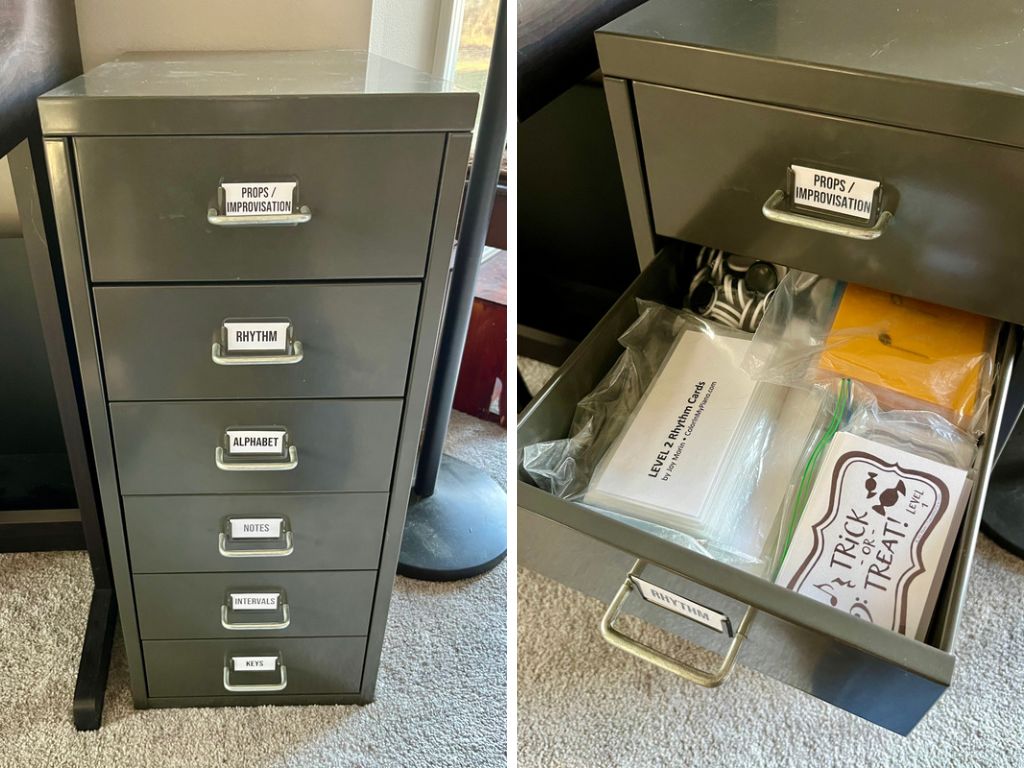
This system works great for me. In a moment of inspiration when a student needs reinforcement with something related to rhythm, piano key names, or whatever, I know exactly where to go. And I can easily create simple games on-the-spot using the basic resources in my drawers.
Here’s how to set it up. Looking at all the items you have, try to come up with a handful of categories by theme or topic. These categories ideally will make your items easily findable. Ask yourself what category would come to mind if you were looking for each particular item.
Below is a list of categories I use, as well as examples of items from each drawer. But any categories will do. Figure out what will work for you!
- Props/Improv — Japanese puzzle erasers, various props for teaching hand shape, Rory’s Story Cubes, Flashcards for Composition/Improvisation, etc.
- Rhythm — leveled rhythm cards, Rhythm Train Game, Rhythmic Value Cards, Trick-or-Treat Rhythm Game, Othello chips, etc.
- Alphabet — this includes piano key flashcards, Scrabble tiles (A-G only), alphabet spinners, alphabet dice, etc.
- Notes — musical alphabet word cards, note-naming flashcards, etc.
- Intervals — Ice Cream Intervals game, interval cards, etc.
- Keys — key signature flashcards/dice, key props and printables, and anything related to chords.
2. Store Larger Games in Plastic Envelopes
The second thing I recommend is purchasing a set of clear plastic envelopes for larger games that won’t fit in your drawer unit or have many loose parts. I first blogged about these envelopes back in 2012, and I still love them! They keep everything contained in one place, and it’s easy to see what’s inside.
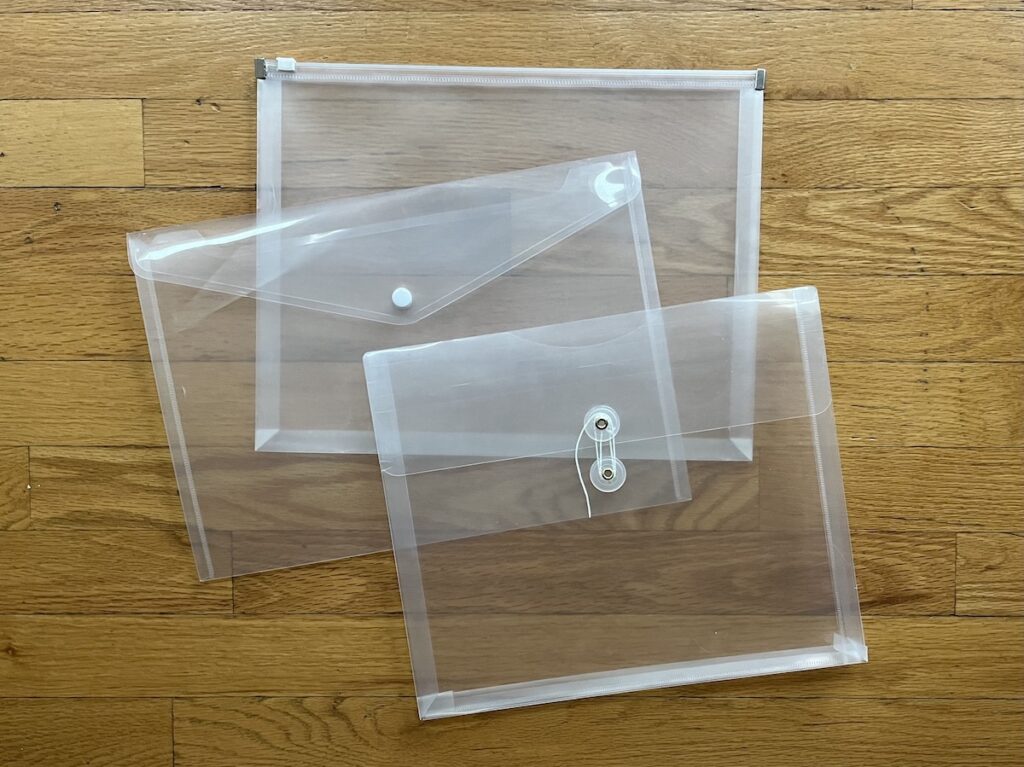
These plastic envelopes come in many sizes (US letter, legal, 5×10, 5×7, 4×6, 3×5 inch sizes, etc) and with various style fasteners (snaps, plastic zippers, string-tie closures, or hook-and-loop “Velcro” fasteners). While you can find them at office supply stores or dollar stores, the best pricing I’ve seen is on Amazon (view an assortment of options here).
Although my favorite fastener style is the zipper, I am disappointed by the fact that they do tend to break after awhile (as do the string-tie closures). Snaps work well, but they do make the envelope thicker. I haven’t tried the hook-and-loop “Velcro” style yet, but plan to try those next. Fortunately, the envelopes aren’t terribly expensive, so they can easily be replaced once they are worn out or broken.
More importantly, you need to know that these plastic envelopes come in either a flat style or expandable style (with a “gusset”). The flat style is more affordable, but expandable sides are nice for games that have dice, plastic game pieces, or a thick stack of flashcards. If you want the expandable style, check carefully before you order and be prepared to pay a little more. You may want a few of each style in order to accommodate your assortment of games and teaching materials.
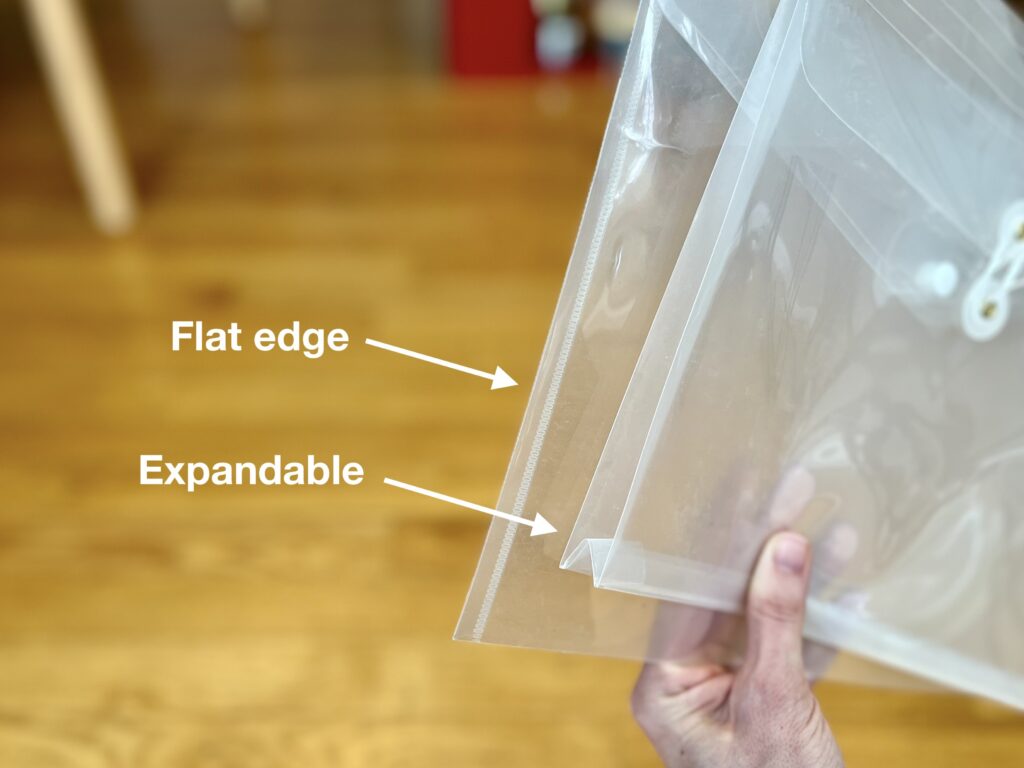
(If you’d like to try some zipper envelopes that are expandable, here’s a nice set that includes two sizes: five 10×14 inch and five 5×10 inch.)
Once filled with games, these plastic envelopes can be stored upright on a shelf, in magazine holders, or inside a drawer. If you have enough to warrant it, you can label them by title or sort them into categories.
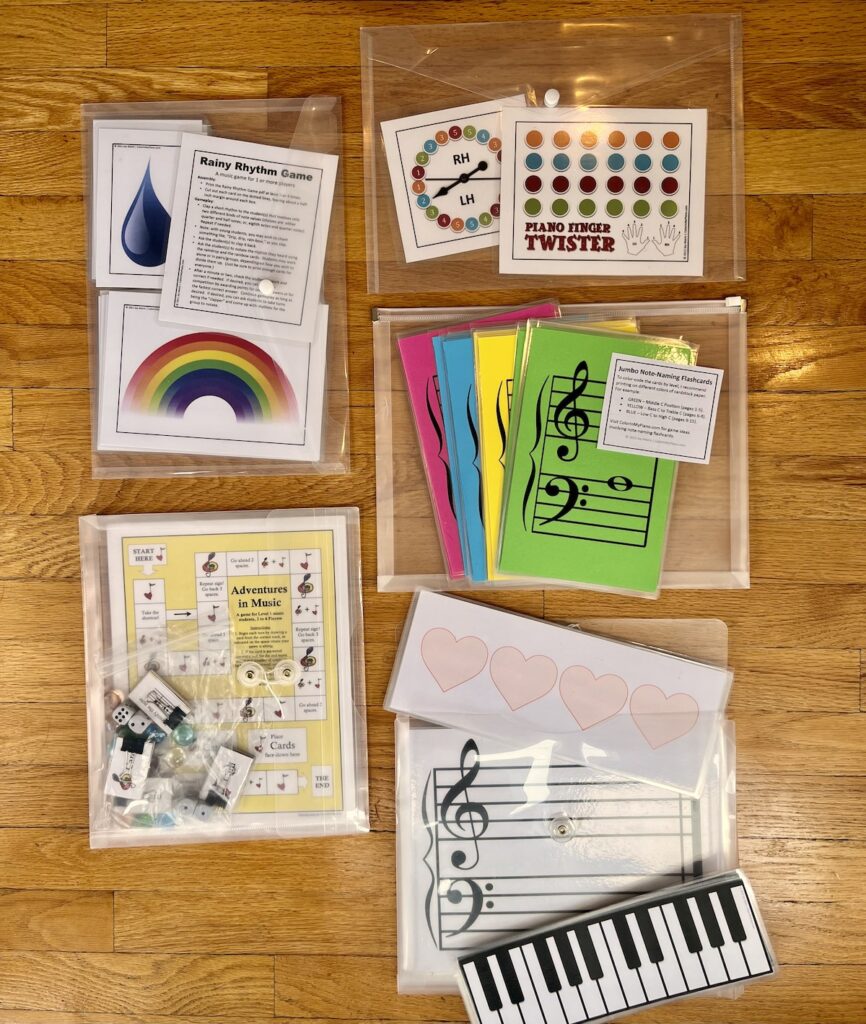
[Pictured above, from top left going clockwise: Rainy Rhythm Game, Piano Finger Twister, Jumbo Note-Naming Flashcards, Heartbeat Charts, Large Grand Staff Sheet, Paper Keyboard, and Adventures in Music game.]
Another storage item I’ve invested in are these vinyl zipper bags. I wanted something extra sturdy and just the right size to hold my Rhythm Value Cards (one of the best freebies on my blog, in my opinion!). I have two complete sets of Rhythm Value Cards printed and laminated (as pictured), because I like to use these for competitive team games.
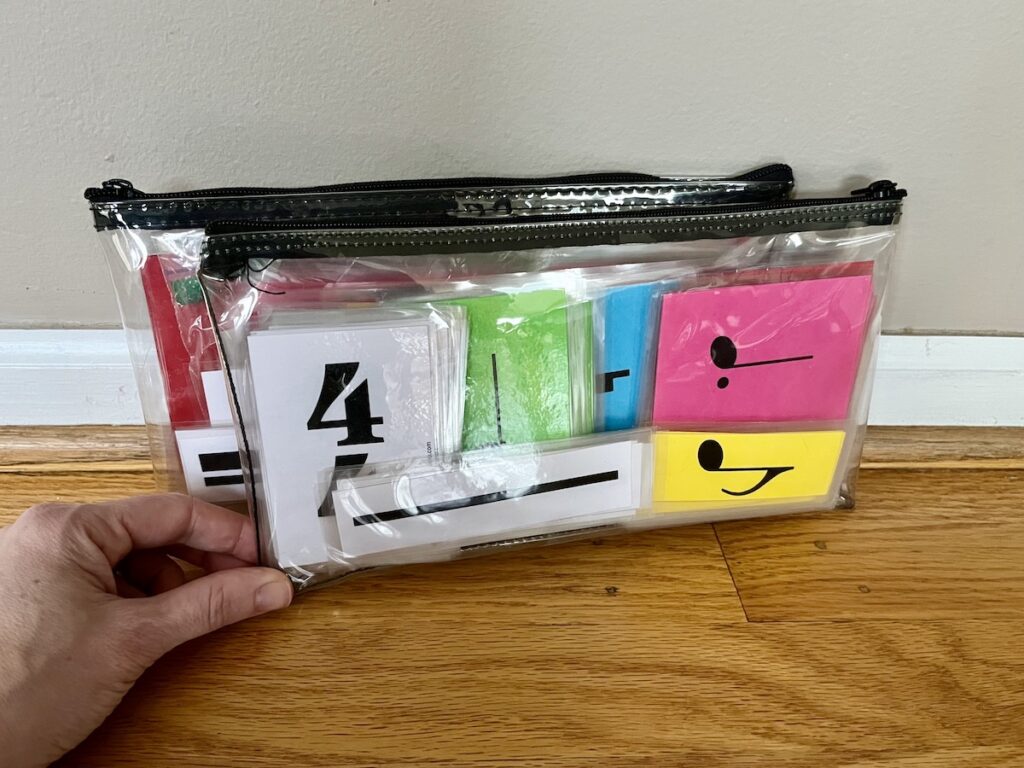
3. Follow a Plan for Keeping Your Teaching Materials Organized
Once you have your games neatly stored and organized, you need a plan for maintaining your system. Here’s my tips for beating clutter and keeping your teaching space tidy and organized.
- Keep only what you really value. Before buying or downloading a new resource, always ask yourself if it is something that works well with your teaching approach and is likely be used with many students for years to come. If you’ve been teaching piano for awhile, you might know how easy it can be to end up with a large collection of games and resources. I try to be selective and minimalist, and investing my time and space only into resources that will contribute something especially fun, helpful, and/or valuable to my students. Even so, it’s necessary to occasionally purge any items you are no longer using. Things change — including our teaching approaches — and that’s okay!
- Everything needs a place. If an item doesn’t yet have a home, make one. Ask yourself: Where would “future me” look for this item? Where could I put this so I would be able to easily find this item during future piano lessons? Consider using labels to make it clear where certain types of items should go.
- When finished, put things back where they belong. I don’t know about you, but I’m happier when my space is tidy and clean as opposed to not! And I think students learn better in a space that is free of an abundance of clutter and distractions. So when possible, put things away immediately after using them. When that isn’t possible, do a quick clean-up at the end of your teaching day or during any breaks you might have between piano lessons. Further, plan for an occasional deep clean, purge, and overhaul of your organizational system — perhaps once every year or two. It can be a big project, but it always feels good in the end!
I hope this post has given you some inspiration as well as practical tips for organizing your favorite piano teaching games and materials. It’s a great feeling when you have your teaching space arranged to create your very own “happy space” and you are able to find the right resources in-the-moment for students. Happy organizing!
Your turn: How do you organize your games and materials? What organizational tips can you share in the comments below?



Hello. I love your organizational ideas. I have a lot of bookcase space in my studio . (Thank you IKEA!) I use plastic sheet protectors from Office Depot to store my games and worksheets in 3 ring binders. I’ve arranged everything by topic (Christmas, Halloween, Key Signatures, Notes & Intervals, Rhythm, etc.) and alphabetize within each topic by title name, adding a post-it with PC file name . I secure the opening with a binder clip. My files on my PC are organized in the same way so it’s easy to find and reprint worksheets when needed. Life saver!
On another topic, My students and I still love your Notes to Self wall! Thanks for your many helpful and creative ideas. Best wishes for a great 2023!
Very nice, Diane! That sounds like effective organization. Thanks for sharing! And I’m so happy to hear you and your students have enjoyed my Notes to Self stickies!!
Joy, I LOVE your posts. The pictures, where to purchase, how to use tips are so valuable. Thank you so much for making us all better at our jobs.
Thank YOU, Doris, for the kind words! I’m happy you found some of my tips valuable!
This is a great post. I’m organized until Christmas, then things need to be “straightened up” a bit. Then it happens again after Spring recital. It’s always nice to see other organizational ideas. Thank you so much, Joy !
Yes, I find there are certain times of year when things need to be “straightened up” in my studio, too. And I’m always inspired by having my space neatly tidied up again! Thanks for your comment, Cheryl!
Thank you so much Joy for the reminder and tips. I am right there after Christmas getting the need to purge and straighten.I have a 4 drawer unit for some small items. Other small cards are in containerss. I feel this could be improved. I use sheet protectors with colored edges color coded by Subject with a contents list in front of the container holding the folders.
Yes, I thought the new year would be a good time of year for a post about organization! 🙂 It’s nice hearing about your system. Sheet protectors are a good idea, too!
You always have great ideas! Thank you for sharing.
Thanks so much, Cyndi! Hope you are doing well!!
I have an old library card catalog with lots of small drawers. I keep all my small game items/cards etc in ziplock bags in these drawers organized by category. Then all my bigger items like game boards and instruction sheets in binders alphabetized by title. I also have an index in the binders that lists all the games by title but also has listed next to the title what the concept is, whether its seasonal to not, and whether I’ve printed it or not. I have a basket on my desk where I put games that I’ve had out, to keep them neat and out of the way until I have time to put them back where they belong.
Ooo, an old library card catalog sounds so great!! And I like your system of having a basket on your desk for games that are ready to be filed back into place. Great idea!